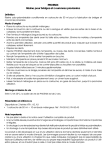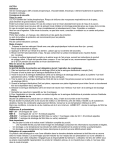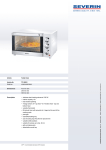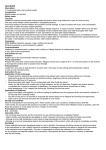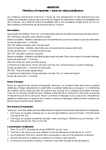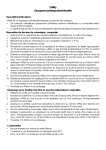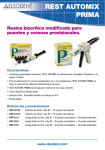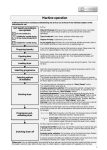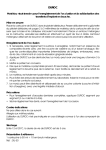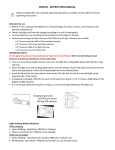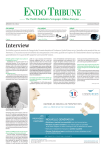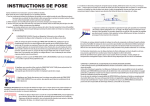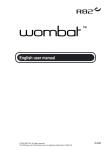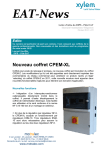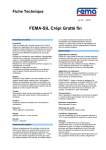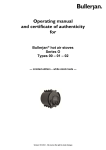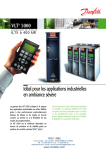Download G ETCH Gel de mordançage acide phosphorique à 38 %
Transcript
G ETCH Gel de mordançage acide phosphorique à 38 % Avantages • • • • Viscosité idéale. Thixotrope. S’élimine facilement et rapidement. Contraste excellent. Mode d’emploi 1. Préparer la dent en nettoyant l’émail avec une pâte prophylactique huile et sans fluor (ex : ponce). Rincer abondamment et sécher. 2. Appliquer G-ETCH sur l’émail et la dentine. Laisser agir sur la dentine 20 secondes. 3. Rincer G-ETCH abondamment à l’eau. Ne pas contaminer la surface mordançée avec d’autres fluides (ex : la salive). 4. Laisser la surface légèrement humide ou la sécher avec de l’air propre, suivant les instructions du produit de collage utilisé. Note L’émail doit paraître blanc crayeux. Si ce n’est pas le cas, recommencer l’application de G-ETCH pendant 20 secondes et rincer abondamment. Mise en oeuvre (jumbo kit) Note importante Le port de lunette de protection est obligatoire durant l’opération de remplissage. 1. Oter les bouchons de la seringue de stockage (50ml) et de la seringue distributrice à remplir (3ml). 2. Pousser à fond le piston de la seringue distributrice de 3ml. 3. Visser le bout de la seringue distributrice (3ml) sur la seringue de stockage (50ml), grâce au système “luer lock” spécialement prévu. Vérifier l’arrimage entre les deux seringues. 4. Tirer le piston de la seringue distributrice (3ml) afin de la remplir. Ne jamais pousser sur le piston de la seringue de stockage (50ml). 5. Quand la seringue distributrice (3ml) est pleine, repousser son piston légèrement pour éviter d’avoir un écoulement lors de la séparation des 2 seringues. 6. Dévisser la seringue distributrice (3ml) en tenant de l’autre main l’embout “luer lock” de la seringue de stockage (50ml). 7. Remettre les capuchons respectifs sur les 2 seringues. 8. Pour l’application en bouche, mettre un embout aiguille sur la seringue distributrice et procéder comme d’habitude. Précautions d’emploi Si G-ETCH entre en contact avec les mains ou la muqueuse, rincer abondamment à l’eau. En cas de contact avec les yeux, suivre la même procédure et prendre un avis médical. Présentation • • • • Seringue de 12 g + 25 embouts aiguilles MINI-SYRINGE KIT : 4 seringues de 1,2 ml + 8 embouts aiguilles. JUMBO KIT:1 seringue de stockage de 50ml + 5 seringues vides de 3ml + 40 embouts aiguilles. 3 seringues de 3ml + 20 embouts aiguilles Conservation et durée de vie Conserver à une température inférieure à 24°C. Dans ces conditions, la durée de vie du matériau est de 2 ans minimum. Kit Jumbo : stocker la seringue de 50ml au frais, à l’abri de la lumière. Les capuchons doivent être parfaitement vissés pour protéger le matériau et empêcher tout dessèchement. Ce matériau a été développé en vue d’une utilisation professionnelle dentaire seulement. Tous dommages résultant d’une autre utilisation n’engagent pas la responsabilité du fabricant ou de son distributeur. L’utilisateur devra sous sa propre responsabilité vérifier la bonne appropriation du produit. MATERIAL SAFETY DATA SHEET SECTION I - PRODUCT INFORMATION Dental Etching Agent G-PHARMA-35, avenue du Gros Chêne BP 10279 Herblay 95617 Cergy- Pontoise 95617 Cergy- Pontoise Cedex - France EMERGENCY TELEPHONE N°: 33 (0)1 30 37 75 75 DATE REVISED: March 17, 2003 GENERAL INFORMATION: 33 (0)1 30 37 75 75 SSECTION II - HAZARDOUS INGREDIENTS Ingredients: Polyacrylic Acid - Phosphoric Acid Hazardous data: 4- extreme HEALTH : 2 3- high 2- moderate FLAMMABILITY: 0 1- slight 0- insignifiant REACTIVITY: 1 Hazardous class: Corrosive SECTION III - PHYSICAL DATA Phosphoric acid concentration: approx. 38% Boiling point: approx. 100° c Percent volatile Wt: 65 Appearance: green light gel Odor: virtually odorless Vapor density VS air: Heavier..............Lighter.....X...... Liquid density VS air: Heavier.......X.......Lighter........ SECTION IV - FIRE AND EXPLOSION DATA Flash point: N/A Explosion limits in air: N/A Flammability classification: Nonflammable Extinguishing media: Nonflammable.Water contact acceptable if involved in fire from other sources. Unuasal fire & explosion hazards: Can react with metals to liberate hydrogen gas which is flammable. Special fire fighting procedures: N/A SECTION V - HEALTH & FIRST AID DATA Health hazards (acute & chronic): Skin irritation or severe burns if prolonged exposure is allowed; possible damage to eyes. Carcinogenecity: Not listed as a carcinigen. Signs & symptoms of overexposure: Skin, eyes and mucous membranes irritation on contact. Medical conditions generally aggraved by overexposure: pre-existing skin disorders or eyes problems. Emergency & first aid procedures: Eye contact: Immediately rinse with copious amounts of water. Seek medical attention as soon as possible. Skin contact: Rinse with water.Prolonged contact may destroy tissue. Seek medical attention in case of serious irritation or burns. Ingestion: Corrosive to mourth and throat. Serve milk if available or solution of sodium bicarbonate. Inhalation: May cause burns of mucous membranes and in severe cases, tissue damage. Medical attention is necessary if manifestation like coughing, chest pain and breathing difficulties occur. SECTION VI - REACTIVITY DATA Stability: Generally stable. Conditions to avoid: Contacts with alkaline materials, reactive metals. Incompatibility with other materials: Reactive metals, alkaline substances. Hazardous decomposition products: Phosphoric acid vapors and phosphoric oxides, if exposed to extreme heat. Conditions to avoid uncontrolled polymerisation: will not occur. SECTION VII - SPILL & DISPOSAL PROCEDURES Steps to be taken to handele spills or releases: Wear impervious clothing and goggles. Waste disposal procedures: Dispose of spilled product in accordance with local, state and federal regulations, after neutralizing with soda ash or lime. For small spills, dilute with large amounts of lime. For small spills, dilute with large amounts of water and dispose in DOT approved waste containers. SECTION VIII - SPECIAL PRECAUTIONS Work / hygienic practises: Avoid contact with skin and eyes. Wear protective gloves, aprons, suits and goggles when handling large quantities, or if splashing or spills may occur. Handling and storing: Store in polyethylene, polypropylene or similar acid-resitant containers. Glass is permissible for small quantities; avoid exposure to heat. Avoid proximity of reactive metals and alkaline substances. DISCLAIMER Some of the information presented and conclusion drawn herein are from sources other than direct test data on the product itself. The information in this MSDS was obtained from sources wich we believe are reliable. However, the information is provided without warranty, expressed or implied, regarding its correctness. The conditions or method of handling, storage, use and disposal of the product are beyond our control and may be beyond our knowledge. For this and other reasons, we do not assume responsability and expressly disclaim liability for loss, damage or expense arising out of or in any way connected with handling, storage, use and disposal of the product. The MSDS was prepared and is to be used only for this product. if the product is used as a component in another product or used in a way other than recommended by G-PHARMA, this MSDS information may not be applicable. 0499 depuis 2002 Ne pas réutiliser Limite de température Conserver au sec Adresse du fabricant Attention, voir notice d’instructions Corrosif G-PHARMA 35, avenue du Gros Chêne B.P. 10279 HERBLAY 95617 CERGY-PONTOISE Cedex FRANCE [email protected] www.elsodent.com



